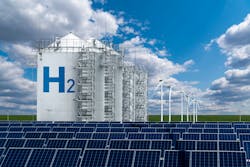Will Hydrogen be the Fuel of Choice for a Low-Carbon Future?
There is substantial support for decarbonizing power production, transportation, manufacturing, and other combustion processes. Climate models indicate lower carbon dioxide (CO2) emissions and therefore lower CO2 concentrations in the atmosphere should slow the earth’s temperature rise. This thinking is a principal factor behind the support for intermittent renewable generation. Lower carbon fuels like natural gas used for baseload, intermediate and backup generation are falling out of favor. Hydrogen (H2) can be combusted without CO2 production, and it can be stored indefinitely to yield a longer discharge duration and capacity than any battery. Will H2 be our savior as we transition to a new energy future?
Wind and solar capacity additions are topping the charts in many parts of the world. Yes, it is partly because they fit the current worldview, but also because the levelized cost of energy (LCOE) from new wind and solar resources has become competitive with many existing and new conventional generation sources. Lazard’s 2021 LCOE report shows new unsubsidized wind and solar plants with LCOE values as low as $26 and $28 $/MWh, respectively, are within the marginal cost of energy range for existing nuclear and gas generation and below those for coal plants. The LCOE range for new gas combined cycle generation is reported as $45 to $74 $/MWh with gas at $3.45/MMBTU.
A major challenge remaining with wind and solar is their intermittency. The largest renewable energy resource globally by capacity is hydroelectric. While not as volatile as wind and solar, hydro also is subject to intermittency issues. For example, an El Nino event can cause weather patterns that reduce water flows for extended periods, thereby limiting capacity availability. Also, there are significant environmental impacts associated with the development of dams and their operation including significant habitat changes, migration impacts and fish entrainment. Moreover, studies show the buildup of organic material in reservoirs can cause more greenhouse gas emissions on a per KWh basis than a gas fired plant. The International Hydropower Association is working on industry practices to address some of hydro’s sustainability issues.
With the list narrowing on carbon-free, baseload generation sources, an obvious option would appear to be nuclear. However, as we know, public sentiment is sometimes harsher on nuclear than we are now experiencing with fossil fuel technologies. The Fukushima accident in March 2011 seemed to be the final straw for nuclear programs in many countries. This is despite the fact that it took a magnitude 9 earthquake and tsunamis to cause the incident, and there have since been widespread modifications to plants worldwide from lessons learned. What is surprising is that Chernobyl did not have this stigmatizing effect 35 years ago. A 1,000-square-mile area corresponding to a 19-mile radius surrounding the Chernobyl plant makes up an exclusion zone that is still too contaminated today for safe entry. While conventional nuclear is off the list for new development in many jurisdictions, there are exceptions, and there is an active advanced nuclear movement working on technologies such as small modular reactors to help address current nuclear concerns.
New natural gas-fired combined cycle is our lowest cost, baseload energy source. Emissions from modern plants are dramatically lower than ever before. However, this does not fully placate the net-zero crowd, and consequently, other firm supply options may be needed. Hydrogen fired gas turbine generators are increasingly being viewed as a prime contender. In addition, H2 can be stored until needed and fired for extended periods when intermittent sources are not available. This addresses the bulk supply dilemma with batteries, which can supply backup service for hours as opposed to days or weeks.
Green H2 is the fuel advocates favor for decarbonizing our energy supply. It is manufactured by hydrolysis using renewable electricity to achieve low CO2 emissions from the fuel creation process. Bulk sources of green H2 do not presently exist as the conventional method of H2 generation utilizes steam methane reforming (SMR) with significant CO2 emissions. Accordingly, the path to a H2 energy supply economy will necessitate substantial H2 manufacturing capability. In addition, present gas turbine technology can accommodate only about 25% H2 co-firing without equipment modifications. Lazard estimates the LCOE for a combined cycle plant burning 20% Green H2 to be $129/MWh.
We have all heard the expression there is no such thing as a free lunch. Clearly, using H2 as a fuel will increase the cost of electricity production. Further, when replacing natural gas for H2 in combustion, the NOx emissions are substantially increased, so we are lowering CO2 emissions and at the same time increasing emissions of another deleterious priority pollutant. It may be wise to keep hydro, nuclear, natural gas and H2 as options, and work to improve the sustainability of all.
About the Author
David Shadle
Grid Optimization Editor
Dave joined the T&D World team as the editor of the Grid Optimization Center of Excellence website in January 2016.
Dave is a power industry veteran with a history of leading environmental and development organizations, championing crucial projects, managing major acquisitions and implementing change. Dave is currently a principal at Power Advance, LLC, an independent consulting firm specializing in power project development, research and analysis, due diligence and valuation support. Dave is also a contributing consultant for Transmission & Distribution World. Prior to Power Advance, Dave held business and power project development positions with The Louis Berger Group, Iberdrola Renewables, FPL Energy and General Public Utilities. He is a graduate of Pennsylvania State University, the New Jersey Institute of Technology and Purdue University.
